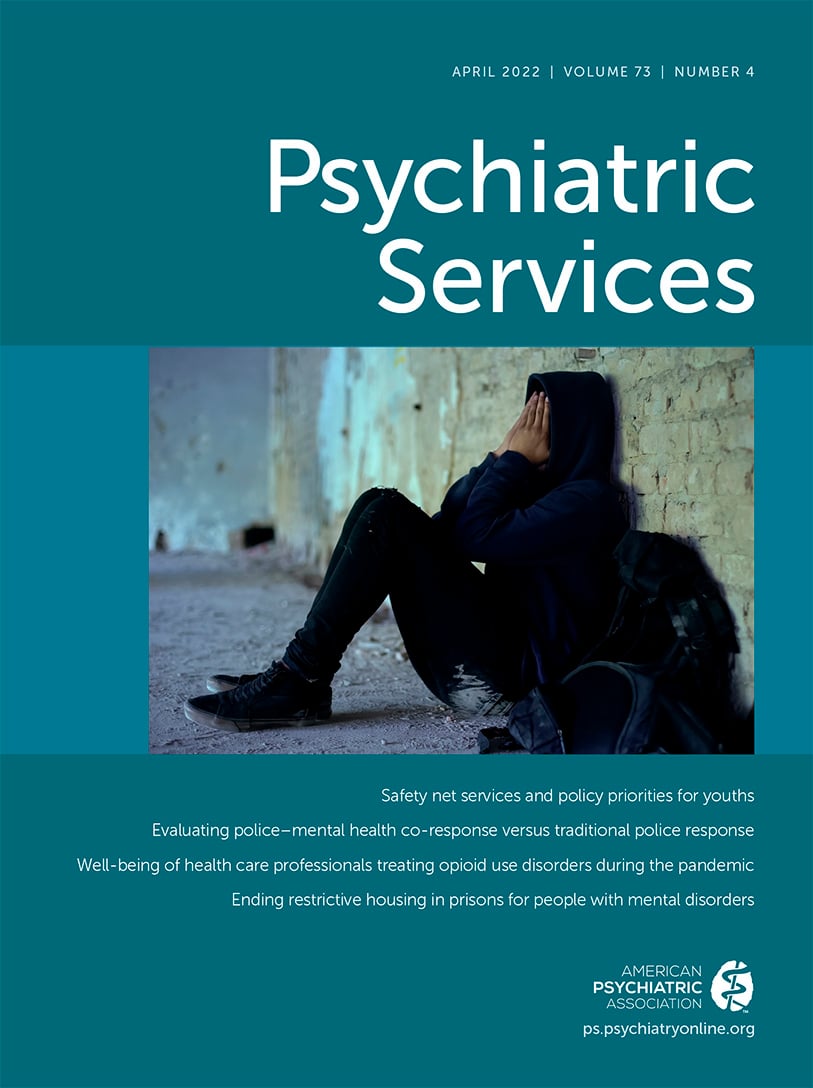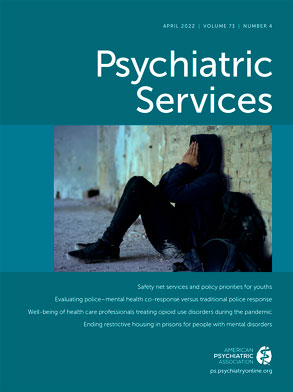Individuals from sexual minority groups have elevated rates of depression, anxiety, substance use disorders, and suicidality relative to their heterosexual counterparts (
1). These differences result from stress due to belonging to a sexual minority group: experiences of sexuality-based stigma that result in increased stress and adverse behavioral and mental health (BMH) outcomes (
2). Research has consistently documented that sexual minority populations experience bias and discrimination when engaging with BMH care providers (
3). Moreover, despite recent studies that have reported parity of sexual minority adults with heterosexual adults in insurance rates after passage of the Patient Protection and Affordable Care Act, sexual minority populations remain disproportionally underinsured (i.e., they have a high cost-sharing burden) (
4).
Although persons from sexual minority groups are more likely than their heterosexual counterparts to visit a BMH professional in the previous year (
5), many sexual minority individuals experience stigma and microaggressions when engaging in BMH care (
3). These findings suggest a disconnect between service use frequency and service satisfaction; sexual minority persons may be more likely to seek mental health care services, but they encounter a BMH workforce that is often ill-equipped to provide good-quality, culturally competent care (
6,
7). In an effort to better understand the need for—and barriers to—BMH care among sexual minority adults, we used nationally representative data to examine differences in self-reported BMH, need for BMH health care, and barriers to BMH care at the intersection of sex and sexual identity.
Methods
We used data from the Association of American Medical Colleges (AAMC) biannual Consumer Survey of Health Care Access (CSHCA), a nationally representative biannual survey of adults in the United States who reported needing health care in the past 12 months (see Fish et al. [
4] for additional information about the study design). Data on mental health measures were limited to waves 12 and 13 of the survey (collected in 2015, N=5,932). BMH measures were offered to participants who reported needing BMH care in the previous 12 months (N=2,891). Secondary data were deidentified and thus were deemed exempt from human subjects review.
Sexual identity (“Do you consider yourself to be heterosexual or straight, gay or lesbian, bisexual, other?”) and sex (“Are you male or female?”) response options were combined to generate an eight-category measure (bisexual female, bisexual male, gay-lesbian female, gay male, heterosexual female, heterosexual male, other sexual minority female, other sexual minority male). BMH was assessed by asking, “In general, would you say your mental health is. . . .” (response options were excellent, very good, good, fair, and poor). Need for BMH care was assessed with the item, “In the last 12 months, did you or a healthcare professional believe you needed behavioral or mental healthcare (such as from a counselor, psychiatrist, or social worker for problems with your mental health, emotions, nerves, or your use of alcohol or drugs)?” (response options were no; yes, only once; and yes, more than once).
We created a four-item index of barriers to BMH care that reflect common challenges faced by sexual minority people when accessing care. Items include, “Thinking about the times you needed behavioral or mental healthcare in the last 12 months, how often were you able to get it?” (response options were sometimes or never, coded as 0, and always, coded as 1); “All things considered, how satisfied are you with the healthcare you received during your most recent behavioral or mental healthcare visit?” (response options were neither satisfied nor dissatisfied, somewhat dissatisfied, or very dissatisfied, all coded as 0, and very satisfied or somewhat satisfied, coded as 1); “Would you recommend the provider who treated you during your most recent behavioral or mental healthcare visit to family and friends?” (response options were unsure or no, coded as 0, and yes, coded as 1); and “Still thinking about your most recent behavioral or mental healthcare visit, how long did you have to wait between the time you made the appointment and the day you actually saw the provider?” (response options were more than a day, coded as 0, and same day, coded as 1). A confirmatory factor analysis identified a single factor with strong factor loadings (λ range 0.567–0.809; Cronbach’s α=0.73, range 0–4).
Covariates included age, race-ethnicity, region, education level, annual household income, employment status, and marital status (coding is available in an
online supplement to this report). Bivariate analyses tested whether our combined sexual identity and sex measure, as well as all sociodemographic factors, were associated with each BMH outcome. We then generated ordinal cumulative complementary log-log models, testing for associations between our combined sexual identity and sex measure and each of the three outcomes.
We used intrascale stochastic imputation to impute missing variables in the health care measures because nonresponse for all variables was low. We imputed missing BMH care items by using all nonmissing BMH items and imputed missing socioeconomic covariates by using all other socioeconomic covariates (i.e., education level, annual household income, and employment status).
Results
Sexual minority participants made up 9.4% of the total sample (for the sample’s sociodemographic characteristics, see a table in the
online supplement). Bivariate results revealed that sexual identity, sex, and all covariates were statistically significantly associated with BMH outcome (p<0.05, see a figure in the
online supplement for predicted probabilities across groups).
In both unadjusted and adjusted models, sexual identity and sex were also associated with all outcomes (
Table 1). Overall, compared with heterosexual men, nearly every other sexual minority group had poorer self-rated BMH, greater need for BMH care, and more barriers to BMH care. Bisexual women reported the poorest BMH (adjusted prevalence ratio [APR]=0.42, 95% confidence interval [CI]=0.35–0.51) and the greatest number of barriers to BMH care (APR=2.29, 95% CI=1.77–2.97), and gay-lesbian women reported the most frequent need for BMH care (APR=1.67, 95% CI=1.28–2.18). Similar patterns were observed for sexual minority men. Gay men in particular reported worse BMH relative to heterosexual men (APR=0.64, 95% CI=0.52–0.78) and higher need for BMH care (APR=1.36, 95% CI=1.05–1.76), but no difference in barriers to BMH care. Compared with heterosexual men, heterosexual women reported poorer BMH (APR=0.74, 95% CI=0.69–0.78) and greater barriers to BMH care (APR=1.21, 95% CI=1.04–1.40) but also less frequent need for BMH care (APR=0.68, 95% CI=0.62–0.74).
Discussion
The findings of this national study of access to mental health care indicate differences in self-reported BMH, need for BMH care, and barriers to BMH care across several groups defined by sexual identity and sex. First, compared with heterosexual men, bisexual women were the only subgroup to report poorer BMH, higher need for BMH care, and a greater number of barriers to receiving BMH care. Generally, bisexual people have a higher risk for psychological distress as a result of marginalization by the broader heterosexual population and stigmatization from others in the sexual minority community (
8). However, bisexual women appear to have unique mental health risks because bisexual men did not report poorer mental health in our adjusted models. It may be that bisexual female respondents may experience additional marginalization (e.g., sexism) that can have a stronger impact on their mental health (
9).
All bisexual participants reported greater need for BMH care compared with heterosexual men. However, only bisexual women in this sample faced greater barriers to accessing BMH care. Sexism may be a factor in bisexual individuals’ access to BMH care, given that all three of the subgroups facing greater barriers to care were female (e.g., bisexual, heterosexual, and other sexual minority women). Previous research (
10)—including analyses of the AAMC CSHCA (
4)—has found that bisexual subgroups are generally younger, have lower educational attainment, and have lower income than gay men and heterosexual men and women. Thus, bisexual respondents’ barriers to accessing BMH care may be partially attributed to care-related expenses and resources (e.g., cost and employment).
Compared with heterosexual men, gay men reported poorer BMH and higher need for BMH care but did not report more barriers to accessing BMH care. Research often identifies differences between sexual minority groups and the heterosexual population in access to health insurance, health care providers, and delayed care; however, when these differences are examined by sex, gay men often have more access to health care services than do lesbian and bisexual women (
11). Thus, although gay men report a higher need for care, they also have greater access to care than their lesbian and bisexual women counterparts. These differences across sexual minority subgroups likely reflect varying and complex experiences of stigma, discrimination, and privilege based on both sexual identity and sex.
More generally, the health needs and experiences of sexual minority women have historically been overshadowed by a focus on gay men, especially in health care. Research on the health of sexual minority groups has historically centered gay (usually White) men’s experiences (
12). This is in part because of the necessary emergence of sexual minority health research during the AIDS crisis. Similar to broader society, a de facto power structure exists within sexual minority communities that has historically privileged gay men, including in the conduct of research (
12). This privilege extends to health care experiences, including health insurance coverage and the ability to afford necessary care. In examining the adjusted and unadjusted models for barriers to BMH care, sexual orientation differences in barriers to care for gay men appear to be related to socioeconomic standing, which likely explains the lack of statistical significance in our adjusted models.
Our study was restricted to adults in the United States who needed care within the past 12 months of the survey. This specification limited our study’s generalizability; disparities may be distinct in an analysis of the general population. Because our index combined four health care barriers, primary drivers of individual-level associations were not precisely identifiable. We were also unable to identify gender-diverse participants in the sample. The “other” sexual minority category is difficult to interpret. Moreover, self-reported measures are subject to bias; administrative claims data would provide more nuanced insight into diagnoses and BMH need. Last, we were unable to examine subgroup differences in intersecting identities (e.g., race-ethnicity); future studies should investigate BMH and treatment access across sexual identity, race-ethnicity, and socioeconomic status, among others.
Despite these limitations, the findings from this study have several implications. Although we did not examine the extent to which treatment (dis)satisfaction was directly related to stigma, efforts to increase mental health care access should consider how specific subgroups (e.g., bisexual women) may be uniquely disadvantaged when accessing care. Moreover, mental health care providers and health systems need to consider how to incorporate policies and practices that do not assume heterosexuality, allow for safe and confidential disclosure of sexual orientation and gender identity, and communicate commitments to lesbian, gay, bisexual, transgender, and queer affirmative practice. A concerted effort also needs to be made to expand training and continuing education and better prepare the mental health workforce to work with sexual minority populations. Last, future studies should examine how microaggressions in health care settings may affect patients’ satisfaction with services. These future studies might use qualitative methods to fully explore these experiences, including differential experiences for people experiencing intersectional oppression.
Conclusions
Relative to heterosexual men, sexual minority men and women were found to have experienced significant disparities in BMH, need for BMH care, and barriers to BMH care. Although these findings echo those of previous studies indicating disproportionate BMH challenges and need for BMH care among sexual minority individuals, barriers to BMH care among sexual minority populations have received limited attention. Given inequitable access in the context of high need, future research and practice should identify and address the factors and mechanisms by which these disparities emerge and are maintained, including health insurance, provider specialties, and socioeconomic status. Addressing barriers to care will ultimately help reduce sexual identity–based mental health disparities.

